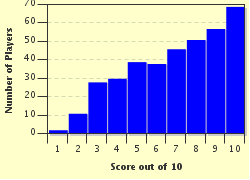Quiz Answer Key and Fun Facts
1. Which of the following statements relating to Cuban geography relative to the rest of the Caribbean is FALSE?
2. For an island, Cuba contains plentiful reserves of natural resources. Most specifically, for years it has been the world's second-largest exporter, after Russia, of which metal used in many commercial transactions?
3. The largest city and capital of Cuba is Havana, located on the island's northwest shore. The second-largest city, however, is on the opposite side of the country, nestling the southeastern shore. What is the name of this city, which was an important site of fighting during both the Cuban Revolution and the Spanish-American War?
4. The main island of Cuba is the largest in the country, but another island off the southwest coast is considered part of Cuba and is the seventh-largest island in the West Indies. What name is given to this "Isle of Youth," which Christopher Columbus named La Evangelista when he visited it in 1494?
5. Aside from the main island, Cuba contains four archipelagos located around different parts of the island's coastline. Which of the following is not one of these island groups?
6. The Pinar del Rio Province is on the northwestern shore and includes sites of natural, historic, and cultural importance. However, this region of Cuba is most famous for the production of which manufactured product?
7. Most people will be familiar with the name of the largest bay on the southeastern part of the island, which shares its name with the Cuban province in which it is located. Jurisdiction over the area has been disputed since the 1903 Cuban-American Treaty. What is this controversial Cuban landmark?
8. Matanzas, Cuba is nearby one of the island's most astounding natural wonders and top tourist destinations. Crystalline domes, stalactites and stalagmites, writing from ancient inhabitants, and a complex series of rivers can be found beneath the earth. What name is given to this locale?
9. With no natural land borders, Cuba is separated from the rest of the Caribbean by water. Which body of water, perhaps named by sailors in the region, separates Cuba from Hispaniola and is often used for shipping between the United States and the Panama Canal?
10. One of the most beautiful resort towns in the Caribbean is located in north Cuba. Also known as "Playa Azul" (Blue Beach), it contains ecological preserves in addition to miles of white, sandy beaches. What is this resort city located on the Hicacos Peninsula that receives hundreds of thousands of tourists each year?
Source: Author
adams627
This quiz was reviewed by FunTrivia editor
Pagiedamon before going online.
Any errors found in FunTrivia content are routinely corrected through our feedback system.

